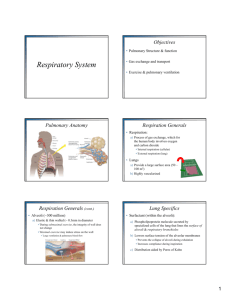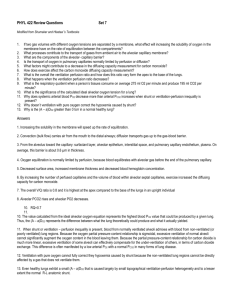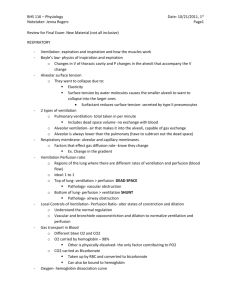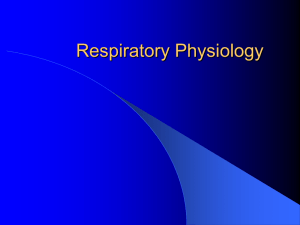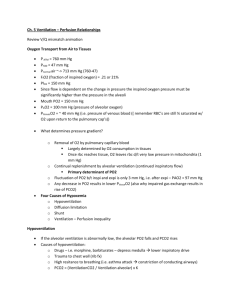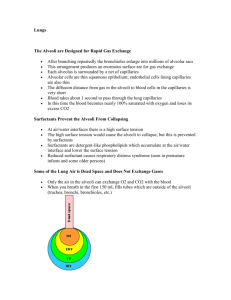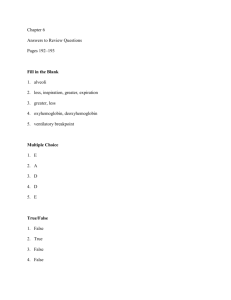Dead Space and Ventilation
advertisement
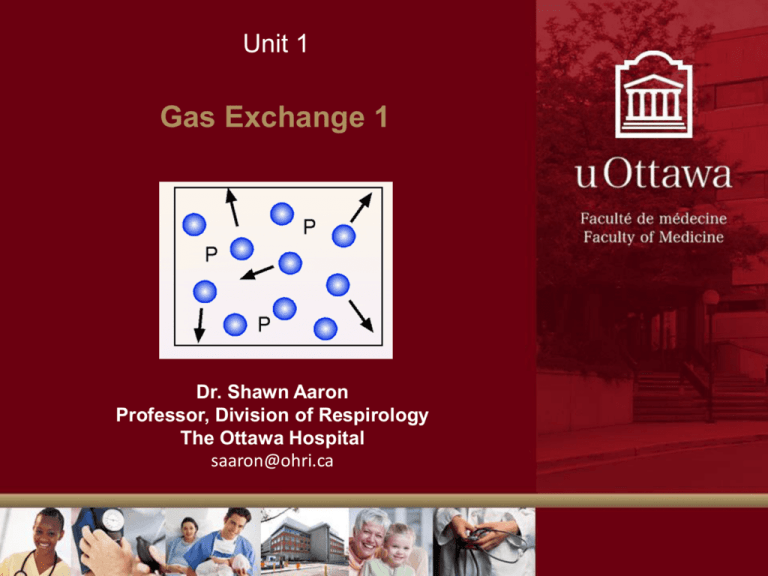
Unit 1 Gas Exchange 1 Dr. Shawn Aaron Professor, Division of Respirology The Ottawa Hospital saaron@ohri.ca Objectives To review: 1) Principles of gas diffusion 2) Ventilation and gas exchange in the lung 3) Concept of dead space 4) V/Q mismatch 5) Shunt [Unit name – Lecture title – Prof name] Physics 101: The Gas Laws • Gas molecules are continuously in motion, they randomly collide with each other and with surrounding surfaces. • Barometric pressure: The earth’s atmosphere exerts a total pressure of 760 mm Hg at sea level. Partial Pressures: • In a mixture of gases: Total pressure = sum of the partial pressures of its components Barometric pressures: • The earth’s atmosphere exerts a total pressure of 760 mm Hg at sea level. • Air is 79% N2 and 21% O2: So: Partial pressure of O2 in air = .21 x 760 mm Hg = 160 mm Hg. Gas Diffusion: • When gas is above a liquid it moves from an area of high pressure low pressure. This is called diffusion. • Each gas moves according to its own pressure gradient without regard to what other gases in the mixture are doing. The Movement of Gases • The lungs work to help us oxygenate our blood and get rid of CO2 • Diffusion of these gases occurs across the alveolar capillary membrane • For diffusion to occur, the partial pressure of O2 in the alveolus must be > than in the pulmonary capillary so that O2 can move from the alveolus to the capillary. • And…the partial pressure of CO2 in the alveolus must be < than in the pulmonary capillary so that CO2 can move out of the capillary to the alveolus. The Lungs have 2 functions: 1. Conduction of Air- this occurs in the conducting airways- the trachea, mainstem bronchi, and the segmental bronchi down to the level of the terminal bronchioles. 2. Exchange of Gases- occurs distal to the terminal bronchiolesie. in the respiratory bronchioles, alveolar ducts, alveolar sacs and alveoli. Movement and Exchange of Gases Conducting airways Gas exchange units of the lung The Alveolar-Capillary Membrane Alveolus Alveolus Diffusion • Oxygen diffuses across the alveolar-capillary membrane into the capillaries and is then bound to HgB. • Carbon dioxide diffuses across the alveolar capillary membrane into the alveoli • Normally, this process is completed the time time blood has traveled 1/3 the length of the alveolar capillary • If the membrane is abnormally thick (pulmonary edema) or transit time is abnormally fast (race horses), process may not be completed and pulmonary venous blood may be deoxygenated Diffusion • Diffusion is proportional to the: – Pressure gradient – Surface area available for diffusion 1000 pulmonary capillaries wrap around each alveolus to create a sheet available for diffusion. Each pulm capillary is 10 um- permits a single RBC to pass. Typical RBC is fully saturated with oxygen once it’s gone 25-33% through the pulm capillary. Diffusion does not typically limit gas exchange. Measuring Diffusing Capacity • Single-breath Diffusing capacity of CO. • Patient takes a vital capacity breath of 0.3% CO and 10% He, holds his breath for 10 seconds, and then exhales. • If one inhales a breath of CO- the amount of CO uptaken into the blood will depend on the partial pressure of CO in the alveoli and the diffusion capacity of the alveolarcapillary apparatus. Thus, VCO= PACO * DCO, or….. • DCO = VCO/PACO Cause of a low Diffusion Capacity: • Loss of surface area for gas exchange= emphysema, pulmonary fibrosis, pneumonectomy. • Loss of pulmonary capillaries = emphysema, pulmonary vascular disease (such as chronic PE’s, pulmonary hypertension, etc). • Anemia • Smoking (because of decreased partial pressure gradient for CO to diffuse into the pulm caps). Ventilation: • The lungs and chest wall serve as a vacuum to suck air into the alveoli. • Inspiration is an active process 1) Diaphragm descends – “piston” 2) Lower ribs flare out – “bucket handle” 3) Sternum swings out – “pump handle” • These 3 movements expand the thoracic cavity and create negative pressure which sucks air in from the mouth alveoli. Ventilation in People • Normally, with each breath, we pull in about 500-600 ml of air (10 mL/kg) = Tidal volume (VT). • Normally, we take 16 breaths/minute = Respiratory Rate (RR). • Minute ventilation (VE) = RR * VT = 16/min * 500 ml = 8 1itres/min. • Does all 8 litres of VE participate in gas exchange? NO…some is wasted ventilation. Wasted ventilation = Dead Space • Dead space = ventilation to an area of lung, but no perfusion. Dead Space and Ventilation Trachea + upper airway = Anatomic dead space = 150 ml (3 mL/kg) trachea lungs If VT = 500 ml, then 350 ml gets to lungs •Alveolar ventilation (VA) = Minute ventilation – dead space ventilation. •Alveolar ventilation (VA) = VE – VD VA = (500*16) – (150*16) = 5600 ml NB: Small, shallow breaths are wasteful proportionally more dead space ventilation The Physiologic Dead Space • Physiologic Dead Space = anatomic dead space + alveolar dead space (alveoli that are ventilated but not perfused) • No perfusion No gas exchange Wasted Ventilation Clinical Example: Massive Pulmonary Embolism • Example of dead space: Massive pulmonary embolism – complete blockage of R pulmonary artery, R lung is still ventilated, but no perfusion • What happens to VA? • Assume RR = 16 and VT = 500 ml • Anatomic dead space = 150 ml • Physiologic dead space = (500-150)/2 = 175 ml • VA = VE – VD = 16 (500 – 150 – 175) = 2.8 litres In summary: 1. Alveolar hypoventilation Failure of gas exchange Build-up of CO2 2. Causes of alveolar hypoventilation: RR Tidal volume Dead space ie. minute ventilation Determinants of alveolar pO2 (pAO2): 1. pO2 in air = 760 * 0.21 = 160 mm Hg 2. Air gets into trachea and is humidified. The partial pressure of H2O in tracheal air is 47 mm Hg. So…partial pressure of O2 in trachea = (760-47) * 0.21 = 150 mm Hg 3. When air gets to alveoli, it mixes with the gas already in the alveolus which contains CO2. Gradients •Alveolar air normally contains about 5.5% CO2 and 15% O2. •PAO2 = (760-47) * 0.15 = 100 mm Hg •PACO2 = (760-47) * 0.55 = 40 mm Hg The Respiratory Quotient • The Respiratory Quotient is the ratio of CO2 production relative to O2 consumption by the body – RQ = VCO2/VO2 • Humans on a regular diet consume more O2 than they produce CO2, so RQ is usually 0.8 • The different rates of movement affect gas tensions in the alveoli – excess removal of O2 elevates the CO2 tension in the alveoli The Alveolar Air Equation: • • • • • Allows us to calculate the composition of alveolar gas. PAO2 = FiO2 (PB – PH2O) – PACO2/RQ Assume RQ = 0.8 Assume PACO2 = PaCO2 = 40 mm Hg If breathing room air: PAO2 = 0.21 (760-47) – (40/0.8) = 150 – 50 = 100 mm Hg • So, when breathing room air at sea level alveolar PO2 is 100 mm Hg arterial PO2 should be 100 mm Hg. Determinants of alveolar PO2: Can figure this out from the alveolar air equation: PAO2 = FiO2 (PB – PH2O) – PACO2/RQ 1. 2. 3. Inspired oxygen fraction (FiO2) Barometric pressure (PB) Alveolar pCO2: a) depends on metabolic rate ( metabolic rate CO2 production) b) depends on alveolar ventilation ( ventilation CO2) Examples: • • Climb Mt. Everest: At 27,000 feet PB = 282 mm Hg PAO2 = 0.21 (282-47) – (40/0.8) = 49-50 = -1 mm Hg!!! So how can anyone climb Everest?! 1. Climb Everest with oxygen: Example: Wearing 40% oxygen PAO2 = 0.40 (282-47) – (40/0.8) = 94 – 50 = 54 mm Hg Effects of Hyper- and Hypo- Ventilation 2. Or…hyperventilate: Breathe pCO2 down to 15 mm Hg: PAO2 = 0.21 (282-47) – (15/0.8) = 49 – 15 = 30 mm Hg • So…we’ve seen that hyperventilation will decrease the PACO2 and increase the PAO2. What about hypoventilation? pACO2 PAO2 • More on Hypoventilation • Example of Hypoventilation: Patient A RR = 16 VT = 500 ml PGY1 gives him morphine overdose • 5 minutes later… RR = 4 VT = 300 ml…YIKES ! • • • • What’s his minute ventilation? What’s his alveolar ventilation? His PCO2 shoots up to 80 mm Hg What’s his PAO2? Hypoventilation in the presence of supplemental O2 One important point: • The effects of hypoventilation on PO2 can be overcome by giving supplemental oxygen. • Example: Patient given morphine, PCO2 = 80 mm Hg PAO2 = 0.21 (760-47) – (80/0.8) = 50 • But, if patient is placed on 28% O2: PAO2 = 0.28 (760-47) – (80/0.8) = 100 NB: He is still acidotic though! Ventilation-Perfusion Matching • Last important concept: V/Q matching • Normally in the alveolus V=Q and V/Q=1 (ie. ventilation to the alveolus = blood flow to the alveolus) • Normally, this is tightly regulated by the body – if ventilation to the alveolus decreases, the pulmonary arteriole will vasoconstrict, proportionally reducing perfusion to the alveolus • Extremes: 1. Dead space = ventilation but no perfusion, V/Q = infinity • Gas delivered to the alveoli won’t participate in gas exchange (delivering oxygen to the body and removing CO2) 2. Shunt: perfusion but no ventilation V/Q = 0 • Blood traveling to the alveoli won’t pick up oxygen or release CO2 Normal V/Q matching 1 unit ventilation 1 unit ventilation pO2 = 100 pCO2 = 40 pO2 = 40 pCO2 = 46 1 unit perfusion pO2 = 100 pCO2 = 40 1 unit perfusion Even a small change in Ventilation matching will cause hypoxemia: 0.5 unit ventilation pO2 = 55 pCO2 = 50 pO2 = 110 pCO2 = 30 pO2 = 40 pCO2 = 46 1 unit perfusion 1.5 units ventilation 1 unit perfusion pO2 = 55 O2 sat = 85% pCO2 = 50 pO2 = 110 O2 sat = 100% pCO2 = 30 Final O2 sat = 92%, PO2= 62, PCO2=40 V/Q Matching in Real Life • V/Q matching goes on all the time – when you stand up the dependent portions of lung (ie. the bases of the lung) are less ventilated. The associated pulmonary arteries vasoconstrict, to maintain V/Q matching and arterial PO2 • When 1 part of lung is diseased (ie. mucous plug blocking an airway and an area of lung), the pulmonary arteries will vasoconstrict to this area, and less blood will flow to the pulmonary capillaries feeding the diseased poorly ventilated area. V/Q matching prevents most people from getting hypoxic V/Q Mismatch: The Main Cause of Hypoxemia • Most diffuse lung diseases cause V/Q mismatch • Even a little V/Q mismatch cause hypoxemia • The ultimate V/Q mismatch is called a Shunt = Section of lung that’s perfused, but not ventilated RLL Pneumonia • PO2 55, PCO2 27 • Give O2 50% • PO2 60, PCO2 33 • Unable to correct O2 • Because of: Shunt
